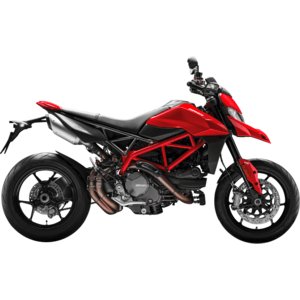Ducati Hypermotard 950 [2019-2022] Review: The Supermoto That Rewrites the Rules
Introduction
The Ducati Hypermotard 950 isn’t just a motorcycle—it’s a declaration of rebellion. Born from Ducati’s legacy of blending track DNA with street aggression, this 2019-2022 generation redefines what a supermoto can be. With its razor-sharp handling, brutish L-twin power, and unmistakable Italian flair, the Hypermotard 950 is a machine that dares you to ride harder, lean deeper, and laugh louder. But does it live up to its "hyper" moniker? Let’s throttle into the details.
Design & Ergonomics: Form Follows Fury
The Hypermotard 950 looks like it’s moving even when parked. Its minimalist bodywork exposes the tubular steel trellis frame, while the high-mounted exhaust and angular LED headlights scream aggression. Ducati offered this generation in bold color schemes like Ducati Red and the urban-inspired Graffiti livery (RVE model), ensuring it stands out in both canyon roads and coffee shop parking lots.
Ergonomics walk a tightrope between supermoto playfulness and street practicality. The 870mm (34.3-inch) seat height might intimidate shorter riders, but the narrow seat profile and wide handlebars give a commanding, upright riding position. The LCD dashboard—with its rev-counter segments and dot-matrix display—feels utilitarian but delivers essential data without clutter.
Engine & Performance: The Testastretta 11° Beast
At the heart of the Hypermotard 950 lies Ducati’s 937cc Testastretta 11° L-twin, tuned to produce 114 HP (83.2 kW) at 9,000 RPM and a spine-tingling 96 Nm (70.8 lb-ft) of torque at 7,250 RPM. This engine isn’t just powerful—it’s characterful. The 11° valve overlap reduction (compared to older Ducati twins) smooths low-end delivery, but twist the throttle, and the beast awakens with a ferocious mid-range punch.
Key Highlights:
- Ride-by-Wire Throttle: Delivers crisp response across three riding modes (Sport, Touring, Urban). Urban mode neuters power to 75 HP for rain or traffic, but Sport mode unleashes full chaos.
- Quickshifter (Optional): Seamless up/down shifts with a metallic snick that’s pure Ducati theater.
- Euro 4 Compliance: Achieved via dual lambda probes and under-tail exhausts (RVE models) that growl with a bass-heavy bark.
Fuel economy sits around 5.1 L/100km (46 mpg), but let’s be honest—you didn’t buy this bike to hypermile.
Handling & Suspension: Urban Acrobat, Canyon Carver
The Hypermotard’s magic lies in its chassis. The 45mm Marzocchi USD forks (170mm/6.7in travel) and Sachs rear monoshock (150mm/5.9in travel) are fully adjustable, letting you dial in stiffness for track days or compliance for potholed streets. With a 25° rake and 104mm (4.1in) trail, it flicks into corners like a trials bike but remains stable at highway speeds.
Brembo Brakes—dual 320mm front discs with radial calipers—offer nuclear stopping power, while the ABS (non-defeatable on base models) intervenes subtly. The Pirelli Diablo Supercorsa tires (120/70-17 front, 180/55-17 rear) grip like geckos, though serious off-roaders might swap them for dual-sport rubber.
Competition: How Does It Stack Up?
The Hypermotard 950 dominates a niche—but here’s how it battles rivals:
- KTM 890 SMT
- Pros: 889cc parallel twin (119 HP), longer suspension travel, off-road capability.
- Cons: Less charismatic engine, plasticky build quality.
-
Verdict: Better for adventurers; Hypermotard wins on road charisma.
-
Aprilia Dorsoduro 900
- Pros: 900cc V-twin (95 HP), lower seat height, aggressive styling.
- Cons: Softer suspension, dated electronics.
-
Verdict: Budget-friendly alternative, but lacks Ducati’s polish.
-
Husqvarna Norden 901
- Pros: Adventure-focused, 889cc KTM engine, upright ergos.
- Cons: Heavier (204kg/450lbs), less playful.
- Veridct: For explorers, not hooligans.
The Hypermotard’s blend of Italian passion and razor-sharp dynamics makes it the segment’s rebel king.
Maintenance: Keeping the Hyper Alive
Ownership demands Ducati-level dedication:
- Desmodromic Valves: Service every 15,000 km (9,300 miles). Unlike conventional springs, Desmo valves require precise shimming—budget $600-$900 per service.
- Oil Changes: Use SAE 15W-50 every 12,000 km (7,500 miles). Capacity: 3.4L (3.6 quarts) with filter.
- Chain Care: The 15/45 sprocket setup wears chains quickly. Clean and lube every 500 km (310 miles).
- Coolant & Brakes: Replace coolant every 2 years and bleed brakes with DOT 4 fluid annually.
Pro Tip: Upgrade to a sprocket kit (14T front for wheelies) or install a slip-on exhaust (Euro 4 headers are restrictive) to unlock the L-twin’s full voice.
Conclusion: The Joy of Rebellion
The Ducati Hypermotard 950 isn’t for everyone—and that’s the point. It’s a motorcycle that rewards skill, punishes complacency, and turns every ride into an event. Whether you’re carving Alpine passes or popping wheelies on an empty industrial road, the Hyper reminds you why you fell in love with two wheels. Sure, the seat’s tall, the maintenance is pricey, and your neighbors will hate the cold starts. But for those who crave a machine that’s equal parts precision and madness, there’s nothing quite like it.
Ready to make it yours? MOTOPARTS.store has the upgrades to sharpen its claws even further.



















